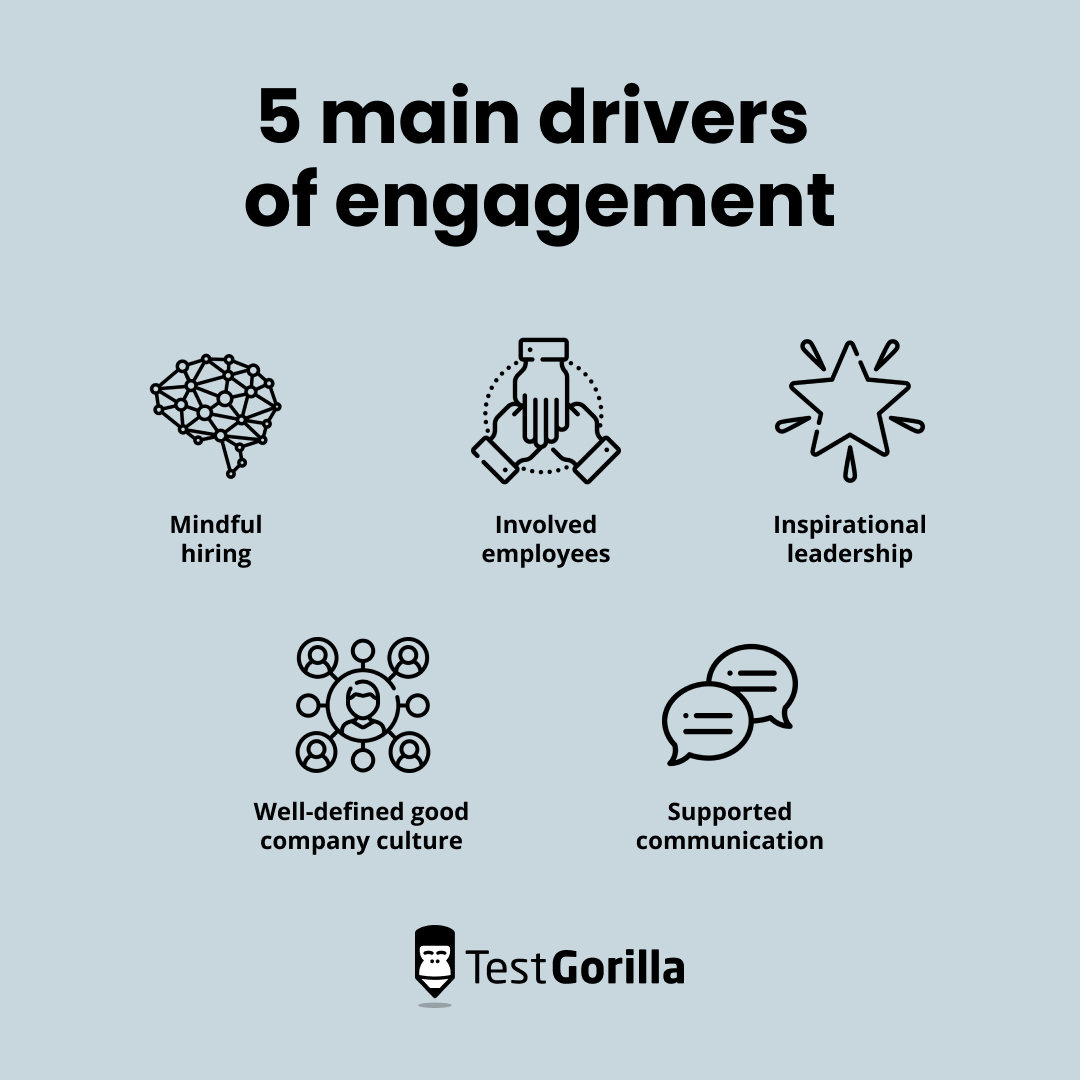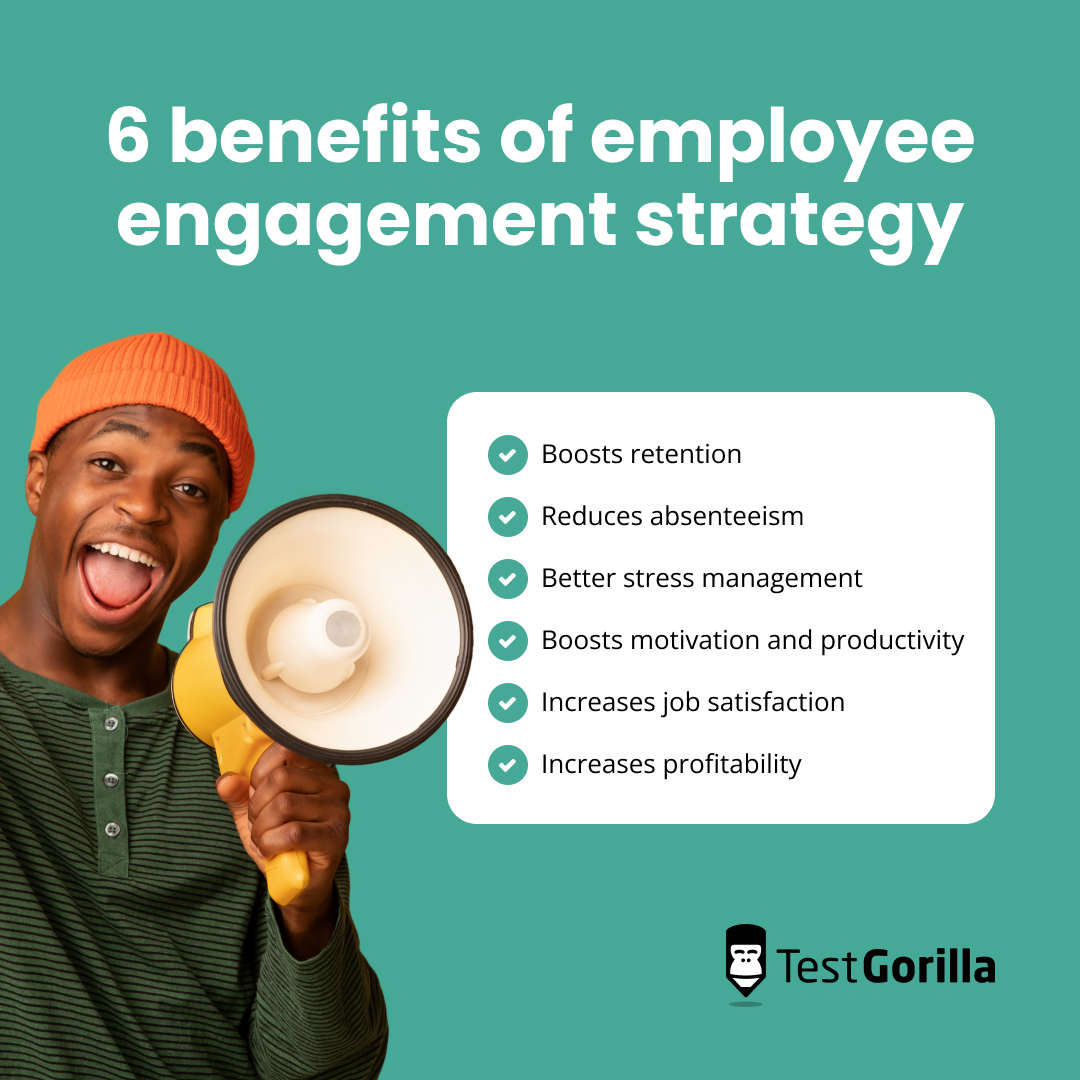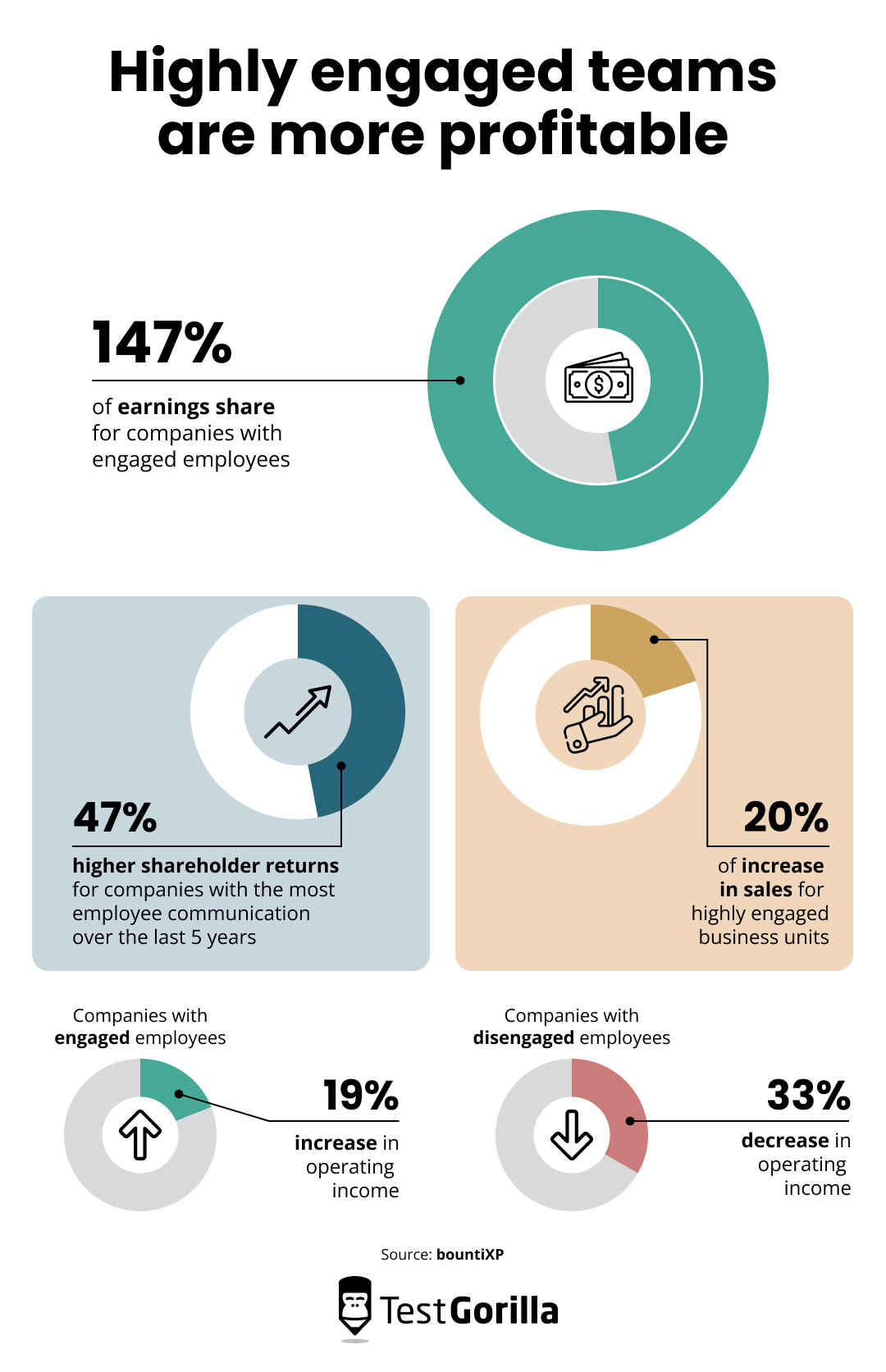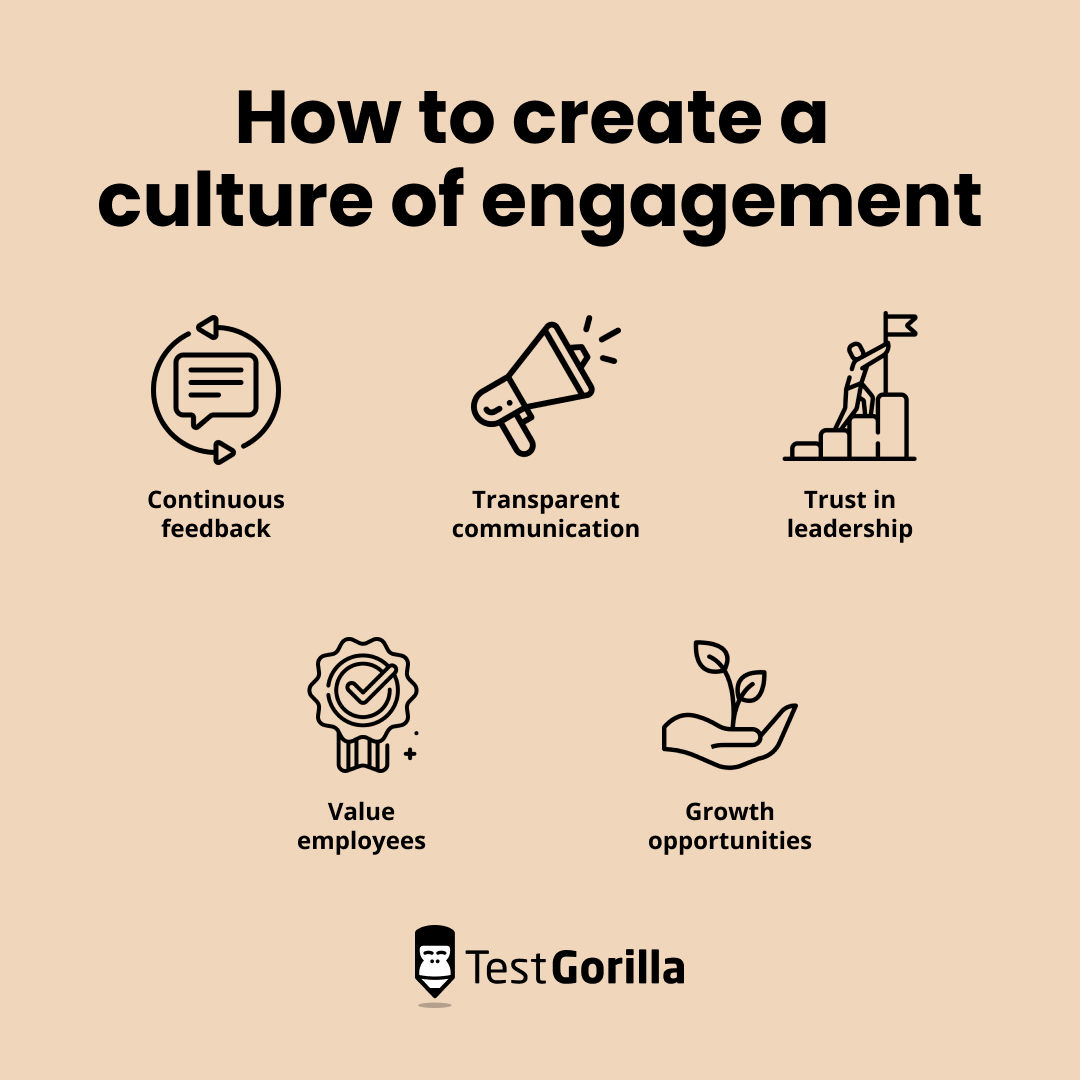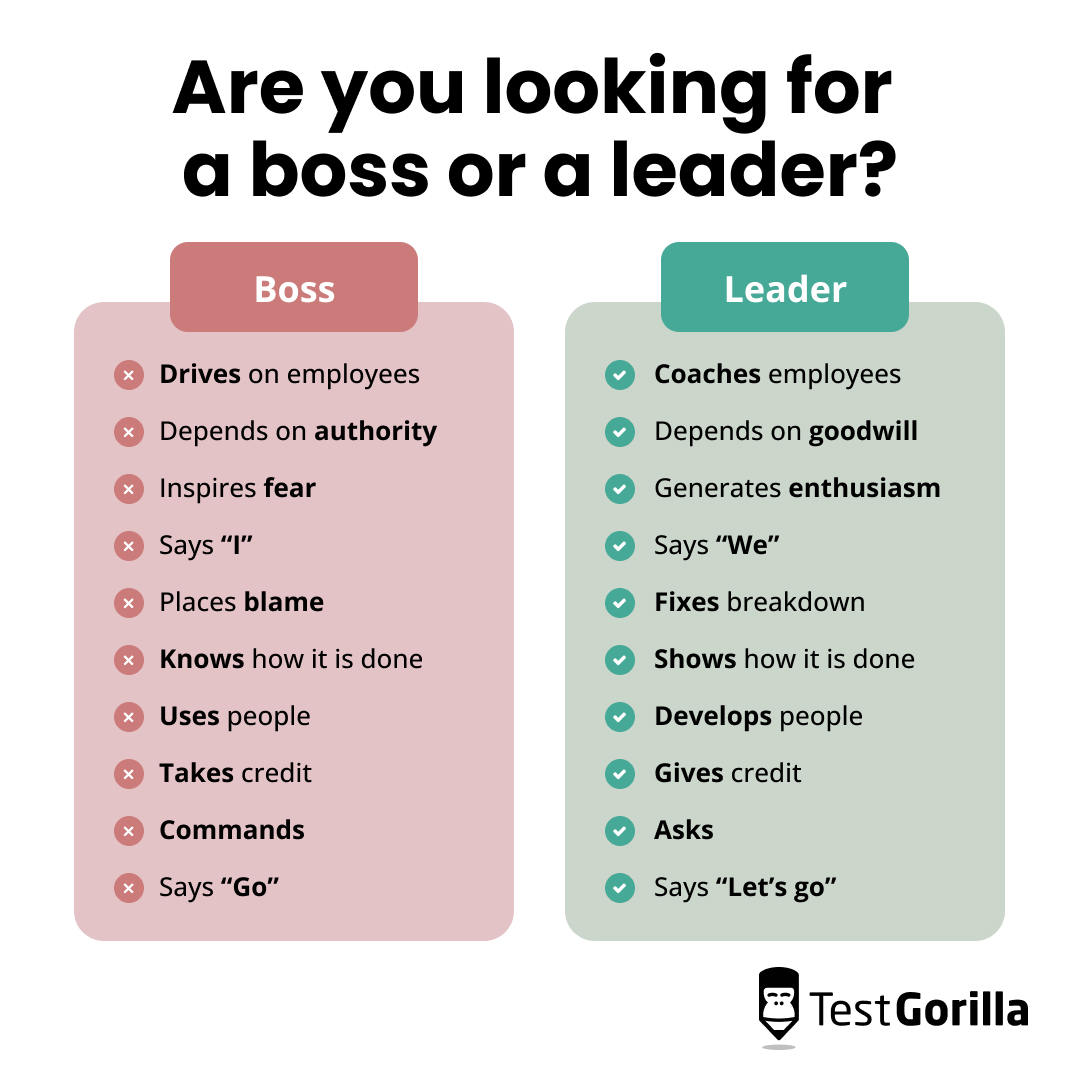Employee engagement: Leverage this talent retention strategy and motivate your people
Companies with engaged employees yield 21% higher profits, and highly engaged employees are 17% more productive.[1]
However, only 36% of US workers are currently showing engagement at work, and globally, just 20% of employees are engaged.[2]
This means that an employee engagement strategy isn't an option you can skim past anymore – it’s a must.
Although employee engagement doesn’t solve everything, it can bring about some incredible results, for example:
Improving employee retention rates
Increasing employee motivation and job satisfaction
Reducing absenteeism and stress levels
Strengthening customer experience and customer satisfaction
In this guide, we show you the drivers of employee engagement and why you need to create strong employee retention strategies – along with tips and case studies to help you discover the best out of this practice.
Table of contents
- What is employee engagement?
- Why is employee engagement important?
- The benefits of employee engagement strategy
- 8 best practices for leveraging employee engagement to retain your best performers
- 3 examples of companies succeeding with employee engagement as a talent retention strategy
- Make employee engagement part of your long-term vision
What is employee engagement?
Employee engagement is the degree of emotional allegiance that an employee has towards the organization they work with. How they act, feel, and think within an organization results from their connection to their team, job, and business.
High levels of employee engagement often lead employees to never want to miss work, to go the extra mile, and to stay for the long haul. Employees who experience low levels of engagement are more likely to undergo burnout, leave the company, or abuse absenteeism.
A positively engaged employee has an emotional connection to their job, which is why they do their best. Employees lacking positive engagement use it as a means to an end, or in other words, a paycheck.
Employee engagement not only has the potential to boost morale and reduce tardiness, but it can also ignite enthusiasm in each employee to reach higher levels of success in their job.
This drive encourages them to take extra steps to be successful in their role – even without being asked to do so. This also helps employers better take advantage of employee retention trends, using them to further improve their retention-related metrics.
The difference between engagement and other related terms
To clear up any confusion, it's important to note that engagement doesn't necessarily indicate job satisfaction.
Job satisfaction relates to how an employee feels about their work, while engagement relates to the dedication an employee has.
Forbes reports that although employee satisfaction is an important contributor to a successful workplace, increasing employee engagement could be even more beneficial.[3]
There are a few other terms that might seem similar, but they're distinctly different:
Employee experience: Employee experience is the sum of all the interactions a worker has with a business during their employee lifecycle. This includes their experience with the work they do and how they’re affected by their work environment.
Employee happiness: This refers to a person's positive attitude and outlook about their workplace. It can be driven by an employee’s satisfaction with their work or the workplace culture, so long as their opinion about their job is a net positive.
Employee wellbeing: Employee wellbeing encompasses the health and contentment of employees in every aspect of their careers, such as psychological and physical health, job gratification, and balance between work and their personal lives.
5 main drivers of engagement
Employee engagement is not something you can enforce through policy – it relates more to how an employee feels. Because of that, you need to understand the five main drivers behind it.
Let’s quickly zoom in on each of the five main drivers:
Mindful hiring (a.k.a. inclusive hiring): Hiring people with the right attitude and soft skills can help engage your team, as opposed to hiring people lacking interpersonal skills
Involved employees: An involved employee naturally feels more engaged and like they belong
Inspirational leadership: Leaders who are good examples to look up to keep employees engaged more than simply “bossing” them
Well-defined good company culture: This sets the baseline for how your employees engage with your business and each other
Supported communication: The right type of communication can help employees to feel more open to speak to each other and their managers about problems
Why is employee engagement important?
Many executives mistakenly believe that employee engagement factors are directly related to employee compensation or benefits, and thus often overlook its other drivers and miss out on its benefits.
Another prevalent assumption is that high employee turnover rates are due to the absence of promotional opportunities or the appeal of a superior job package from another employer.
Employee engagement, connection, and communication are typically the three biggest aspects of a company’s success.
Research has revealed that 92% of business executives now acknowledge that employees who are engaged in their work positively affect teams and organizations as a whole, resulting in improved performance reviews.[4]
With effective employee engagement strategies, organizations promote an improved work atmosphere, reduce employee attrition, boost efficiency, build better customer and working relationships, and improve company profits. This should go hand-in-hand with improving employee satisfaction – a critical concept related to (but not synonymous with) employee engagement.
Employees greatly benefit from them because they help them perform their work better and more efficiently, giving them more meaning and purpose.
The best insights on HR and recruitment, delivered to your inbox.
Biweekly updates. No spam. Unsubscribe any time.
The benefits of employee engagement strategy
By using an employee engagement initiative, you can keep your employees around for much longer and also motivate them to perform better.
Let’s explore this strategy's six major benefits in more detail.
1. Boosts retention
Employee retention rates can make or break a company's overall productivity. For more insight into productivity, check out our guide to the key statistics on employee productivity.
If you want a high-performing team, you need your team to stick with your company. Even worse, when a long-term top-talent employee leaves, they often take with them a wealth of knowledge and experience, which takes time, resources, and effort to replace.
Engaging your employees is one of the most effective strategies that can help to boost your employee retention rates.
In fact, the Oxford Handbook of Positive Psychology at Work states that engaged employees are a whopping 87% less likely to leave a company.
Focusing on engagement efforts leads to a more stable team. A stable team is the perfect “potting soil” for employees to grow their work knowledge and experience. It’s also one of the best ways to scale your team and your business.
Aside from those reasons, strong employee engagement and retention strategies mean you also spend less time and resources on recruiting and training new employees.
2. Reduces absenteeism
There's a direct link between low levels of employee engagement and high levels of employee absenteeism. It’s simple: If an employee isn’t engaged, they don’t want to go to work and may find any excuse they can to remain absent.
A common cause of absenteeism is an unhealthy work-life balance, which makes employee satisfaction, motivation, and productivity drop dramatically. In the US alone, almost one million people are absent from their jobs on any given day.[5]
Creating a positive atmosphere that promotes work-life balance can increase employee satisfaction and engagement. Because of this, your staff will be keen to go to work (either virtually or in person) due to their enjoyment of the job.
Gallup’s research backs this up, showing that workplaces with a high level of engagement experience 81% fewer absentees.[6]
3. Better stress management
Stress causes employees to burn out, making them less productive and more likely to feel disengaged.
Engaged employees and disengaged employees are both going to experience stress at work. How stress is handled and the results of it are what sets them apart.
Employees with workplace engagement find it much easier to manage any stress they may experience, and it may even act as a source of motivation. This is because employees who are engaged are more likely to reach out to their supervisors and colleagues for help when required.
Engaged employees feel secure enough to talk about stressful situations with their managers because of the discretionary effort of companies with employee engagement programs to create cultures of openness and support.
According to Gallup, engaged employees also have better social relationships at work and are less prone to burnout or fatigue.[7]
4. Boosts motivation and productivity
A motivated person is more productive than one with no real goals or one who's simply doing a job to survive or earn money.
Thankfully, engaged employees are highly motivated to do their jobs, and this motivation also boosts their productivity.
According to SHRM research, employees who are engaged are more likely to support the organization in reaching its goals.[8]
This means that when a company invests in their employees' engagement, they see great returns in the form of a more productive and motivated workforce.
5. Increases job satisfaction
Actively engaging employees helps them to feel more satisfied about their jobs.
Employees who aren't engaged in their jobs may experience a variety of negative emotions, such as exhaustion, stress, isolation, depression, and anger.
Employees who are engaged in their work are typically content, valued by management, understanding of their worth to the company, enthusiastic, and happy to perform their duties.
A well-planned employee engagement program keeps worker satisfaction in mind and finds ways to help them feel more satisfied about their responsibilities and the company's goals.
6. Increases profitability
Workers perform at their best when they’re engaged – and without that engagement, there are significant consequences for your bottom line.
Yet another study by Gallup reveals that US businesses lose an estimated $450-$550bn annually from staff members who aren't engaged.
Broken down to an individual level, this means that for every $10,000 of salary paid to an unengaged employee, a company stands to lose up to $3,400 in productivity.
As we already saw with Gallup's research, highly engaged teams are more profitable In fact, when you invest in your employee engagement plan, you might even see a better ROI:
8 best practices for leveraging employee engagement to retain your best performers
Next, we take a closer look at how businesses and managers can get the most out of their employee engagement strategies.
How to build an employee engagement strategy: 8 proven practices
Practice | Summary |
1. Focus on building an inclusive culture | Create an inclusive work culture with skill-based hiring and practices |
2. Create a culture of engagement | Let your employees feel like they are in a safe environment that values them and supports their goals |
3. Send out employee engagement surveys | Use engagement surveys to build engagement plans or to identify disengagement symptoms in employees |
4. Leverage an employee engagement platform | Use an engagement platform so that your employees can communicate and interact with each other and managers |
5. Hire motivated employees | Rely on talent assessment to evaluate employees and see if they’re a cultural add |
6. Invest in your employee's career growth | Upskill your employees by investing in their career growth |
7. Encourage positive, competent managers | Train your managers to act as servant leaders to unlock your workforce’s potential |
8. Start the employee experience right with a great onboarding process | Appoint mentors to new employees to help engage them early on |
1. Focus on building an inclusive culture
An inclusive culture is when everyone feels accepted, respected, and acknowledged.
When people feel at ease and can be their true selves, it leads them to engage more with their work and the people within it.
Engaged employees tend to participate in team-building activities, contribute to meetings, greet coworkers in the morning, brainstorm with their team, and arrive at and complete work on time.
The more inclusive the workplace, the more likely team members are to embrace these behaviors naturally.
Recognizing people for their skills instead of their backgrounds is a great way to foster an inclusive culture.
Skills-based practices lead to a more inclusive environment, namely because the removal of bias from skills-based hiring increases diversity. In fact, 84% of employers who use skills-based hiring have seen a positive effect on diversity.
2. Create a culture of engagement
You can combine an inclusive culture with an engaged one.
You may be aware that a solid corporate culture can greatly boost your organization's financial performance. It can also help to keep your employees around since nearly half of jobseekers are looking to switch employers due to a negative work culture.[9]
Strengthening your work culture creates a positive environment in which your team can excel and engage with each other and your business.
To do this, talk to your employees, recognize them, and give them constructive feedback.
It's also important to encourage upward feedback. For example, ask where leadership communication could be improved or if they need more challenges.
Upward feedback creates a safe environment for people to communicate at work – when everyone feels like they are heard, engagement thrives.
There are a few other key ways you can help to grow a culture of engagement:
You can also encourage your managers to give constructive feedback and avoid criticizing or finger-pointing. This can help your employees and managers to solve issues together and have empathy, which makes them engage positively with each other.
3. Send out employee engagement surveys
Employee engagement surveys help you track engagement, measure metrics, and plan your strategy.
Using these pulse surveys is a lightweight way to gauge everyone's current level. It's also a good way to spot engagement issues early on so that you can prevent them from becoming a bigger problem later.
Let’s say you send out a survey to your team, and after evaluating them, notice one member is showing symptoms of disengagement. You can then have a one-on-one meeting with this employee where you discuss what’s going on so that you can get them back on track.
After your check-in with the employee, you come up with an action plan to keep them engaged. For example, they may be in need of a more accommodating schedule. Or, perhaps the employee is better engaged when only assigned to a specific type of project.
It’s best to send out these surveys regularly (say, every 1 to 3 months) so that you can more accurately track engagement levels.
You can also use these surveys to see if there are any ways you can improve your engagement strategy.
4. Leverage an employee engagement platform
Employee engagement platforms help managers and organizations track, measure, encourage, and understand workforce engagement.
These tools are typically equipped with functions that are intended to facilitate:
Internal communication (also great for engaging remote employees)
Measure worker morale
Optimize the employee experience
Acknowledge accomplishments
Foster a healthy work-life balance
Using engagement technology in the workplace not only impacts employee productivity. It also gives employees a medium to share their opinions, which can help to feel heard and more engaged.
Trade Press Services states that efficient inner communications can encourage 85% of workers to become more dedicated in the workplace.[10]
The ideal employee engagement platform should be flexible so that you can tailor the experience to each employee. When you do this, you engage your employees more positively as opposed to making them feel like they are using a generic platform.
For HR departments, employee engagement software pulls together all the information they need to understand what’s happening across the organization.
Through these platforms, they can draw actionable insights from real-time employee feedback, such as dips in employee motivation related to a specific event or which internal communications resonate best with the workforce.
5. Hire motivated employees
People with the right motivation and values that align with your organization are easier to engage.
Hiring people who are already motivated means you need to put in less effort to engage them, and they'll also reinforce an engaged culture to help you motivate your current team.
Using best hiring practices is a great way to make sure you hire motivated workers.
While interviewing, you should evaluate a candidate's attitude and “culture add” in addition to their skills and experience. You can evaluate them on these with Personality and Culture tests to gauge their motivation and cultural values. You can also use behavioral and situational interviews, reference checks, and other evaluation tools.
Using challenging questions like asking about weaknesses, failures, or times when things didn't go according to plan can yield unrehearsed answers that may illuminate more about their character, motivations, stress reactions, and fit. Candidate screening like this helps employers learn details that usually take a few months of employment to emerge.
6. Invest in your employee's career growth
Employee career growth is the long-term ambition employees have for their job and the steps they take to achieve it, which often correlates with how well they engage with the company they work with.
Employees often seek new opportunities for career growth because they are looking for chances to keep learning and become better at what they do. According to a recent survey, 33% of employees abandon ship because they feel bored in the workplace and are looking for more challenges.[11]
In a different survey, only 29% of employees marked that they were “very satisfied” with the available career advancement opportunities. A further 41% marked that new opportunities were “very important” because they offered more job satisfaction and engagement.[12]
Those statistics show how important employee retention strategies are and why investing in employee career growth is a must if you want to keep them.
One effective way to invest in your staff is by upskilling them with boot camps, courses, employee coaching, or using a professional development plan.
These training methods are also highly effective in positively engaging your team. When done properly, you gain a rich pool of engaged employees with strong work-related skills.
7. Encourage positive, competent managers
A manager's actions and behaviors have a ripple effect on employees and their engagement levels.
While creating your employee engagement plan, you should think about more than just the individual requirements of your staff members. Also, consider the role of middle management and how it shapes workforce outcomes. When you successfully train leaders on how to be good managers, it amplifies how well they can engage with employees.
A good way to plan for this is to get a baseline of their current skills with a Leadership test and then develop them into good servant leaders from there.
Servant leaders are happy to step in and work on the nitty-gritty alongside their team so that they can succeed. This engages employees more, so they can deliver better results and gain more respect across the business.
Servant leaders are different from bosses in many distinct ways:
Servant leaders also excel at positive communication. A timely compliment can do wonders in terms of inspiring staff and keeping them engaged throughout their employment with a company.
Research shows that employee recognition inspires 37% of staff members.[13]
8. Start new employees right with a great onboarding process that engages them early on
Employee onboarding is the first impression that many staff members get of your company and the work culture.
Your employee onboarding process sets the foundation for how new employees engage with your work and team, and it'll affect how long it takes for them to reach their full potential.
The initial days when a new employee begins with a company are essential for developing a strong and lasting connection and setting the pace for the rest of the employee experience.
Mentorships or employee coaching early on can help employees improve their performance, plan their career paths, and manage the stresses of their roles. This gives your newbies a practical goal to strive for in terms of employee development and engages them early on.
Employee coaching is especially helpful in jobs that require a great deal of independence, which is why it is one of the top onboarding best practices. Experienced peers can help their mentee in establishing an effective routine.
Mentors who are peers of their mentees can understand the mentee's situation and offer them assistance.
These peer relationships can also be advantageous to mentors. Mentoring someone else helps them review and reinforce their own knowledge, making them look good too. This positive engagement-boosting practice can greatly benefit both parties and your company.
3 examples of companies succeeding with employee engagement as a talent retention strategy
Engagement has come a long way over the past few years, and many companies are taking advantage of it in innovative ways.
Below, we explore what three tech giants are doing to better engage their employees.
Companies succeeding with employee engagement: A summary
Organization | Summary |
Google engages employees using an inclusive culture, flexible schedules, and inspiration | |
Cisco | Cisco uses professional and personal recognition programs to engage its employees |
Salesforce | Salesforce supports its employees with paid volunteer times, charitable donations, and welfare programs |
Google is one of the most powerful companies in the world with a strong reputation for its unique, engaging company culture and engagement strategies.
For six years in a row, Google consistently ranked at the top spot on Fortune's list of ‘Best Companies to Work For.’[14] Additionally, Google has garnered an impressive 4.4 rating on Glassdoor from more than 48,000 employee reviews.[15]
To do this, it has successfully implemented several employee engagement ideas:
Flexible schedules: Google offers its staff the ability to work on their own terms through a flexible schedule, which encourages creativity and boosts productivity. The staff has been given unlimited autonomy to carry out their job in the manner that suits them best, which drives engagement levels.
Inclusive culture: Google encourages a creative and secure environment for its employees to make sure they feel comfortable and content in their jobs, regardless of where they’re from or where they work.
Promotes inspiration: Google gives each employee up to 20% of their work week to pursue projects that inspire them. This idea can invigorate employees, giving them the opportunity to focus on activities they're enthusiastic about. It prohibits feelings of exhaustion, reduces employee turnover, and increases engagement.
Cisco
Cisco owes its success to its talented and productive staff. This tech behemoth, with its global team, has a complex plan to engage employees from a variety of divisions and areas.
Cisco's employee engagement activities include:
Cisco's employee recognition program focuses on celebrating both professional and personal accomplishments outside of work, which engages workers since it makes them feel like the company cares about more than just their professional input.
Cisco also has a series of strategies that create clear and open communication channels. For example, the company set up communication channels between employees and upper management on birthdays so that their employees can learn more about them.
Salesforce
Salesforce engages its employees with a range of exclusive and attractive rewards and employee benefits. These efforts align with the company's core values and commitment to its local communities.
The top three strategies it uses to increase employee engagement are:
Paid volunteer time: Employees are given 56 hours of paid leave per year to do volunteer work in their community of choice. The company also supports employees who donate to charities, matching up to $5,000 in donations.
Diversity and inclusion groups: Employees have the choice to join equality groups, which are groups of staff that focus on shared backgrounds, identities, or interests. This helps to drive positive engagement.
Focus on wellness and work-life balance: Salesforce also has a wellness reimbursement program for employees. It gives employees $100 a month to spend on any wellness activity, like yoga classes, nutrition programs, and gyms.
Make employee engagement part of your long-term vision
Using an employee engagement program helps to keep your employees around and your company ahead of the curve.
Employees want to work for a business that engages them, and they help to create an engaging work culture that drives the whole team.
Implement some of these strategies to start engaging your employees more positively in the workplace, like creating an inclusive culture and using talent assessments to make sure workers have the right interpersonal skills for their jobs.
For more information, check out our guide on employee wellbeing, a factor that directly affects engagement.
If you’re looking to set up an assessment process that can help you pick the right candidate for your team, take a look at our collection of skills tests.
Sources
1. Harter, Jim. (April 12, 2017). “Employee Engagement vs. Employee Satisfaction and Organizational Culture”. Gallup. Retrieved November 21, 2023. https://www.gallup.com/workplace/236366/right-culture-not-employee-satisfaction.aspx
2. Harter, Jim. (July 29, 2021). “U.S. Employee Engagement Data Hold Steady in First Half of 2021”. Gallup. Retrieved November 21, 2023. https://www.gallup.com/workplace/352949/employee-engagement-holds-steady-first-half-2021.aspx
3. Kruse, Kevin. (Jun 22, 2012). “Employee Engagement What and Why”. Forbes. Retrieved November 21, 2023. https://www.forbes.com/sites/kevinkruse/2012/06/22/employee-engagement-what-and-why/?sh=2811f7867f37
4. “A Winning Approach to Employee Success”. Quantum Workplace. Retrieved November 21, 2023. https://www.quantumworkplace.com/winning-approach-to-employee-success
5. "Workplace Stress". (2022). The American Institute of Stress. Retrieved November 21, 2023. https://www.stress.org/workplace-stress
6. “The Benefits of Employee Engagement”. (June 20, 2013). Gallup. Retrieved November 21, 2023. https://www.gallup.com/workplace/236927/employee-engagement-drives-growth.aspx
7. Almeida, Marie-Lou; Frumar, Camilla. (August 23, 2023). “Help Your Employees Cope With Stress”. Gallup. Retrieved November 21, 2023. https://www.gallup.com/workplace/509726/help-employees-cope-stress.aspx
8. Vance, Robert J. (2006). “Employee Engagement and Commitment”. SHRM. Retrieved November 21, 2023. https://www.shrm.org/hr-today/trends-and-forecasting/special-reports-and-expert-views/Documents/Employee-Engagement-Commitment.pdf
9. “What People Want”. (2017). Hays. Retrieved November 21, 2023. https://www.hays.com/documents/d/hays-usa/what-people-want-us_2017_digital
10. Kinlans, Gerri. (June 12, 2018). “Using Internal Communications to Enhance Business Growth”. Trade Press Services. Retrieved November 21, 2023. https://www.tradepressservices.com/internal-communications/
11. “Breaking Boredom: Job Seekers Jumping Ship for New Challenges in 2018, According to Korn Ferry Survey”. (January 4, 2018). Korn Ferry. Retrieved November 21, 2023. https://www.kornferry.com/about-us/press/breaking-boredom-job-seekers-jumping-ship-for-new-challenges-in-2018-according-to-korn-ferry-survey
12. “Job Satisfaction and Engagement Doors of Opportunity are Open”. (2017). SHRM. Retrieved November 21, 2023. https://www.shrm.org/hr-today/trends-and-forecasting/research-and-surveys/pages/2017-job-satisfaction-and-engagement-doors-of-opportunity-are-open.aspx
13. Cooney, Tom; Faulkner, Crystal. “BusinessWise: Recognition culture”. (2020). Cincinnati Enquirer. Retrieved November 21, 2023. https://www.cincinnati.com/story/money/2020/06/30/businesswise-recognition-culture/3189754001/
14. “100 Best Companies to Work For”. (2017). Fortune. Retrieved November 21, 2023. https://fortune.com/ranking/best-companies/2017/google/
15. “Google: Reviews”. (2023). Glassdoor. Retrieved November 21, 2023. https://www.glassdoor.com/Reviews/Google-Reviews-E9079.htm
You've scrolled this far
Why not try TestGorilla for free, and see what happens when you put skills first.


